
C4
.pdf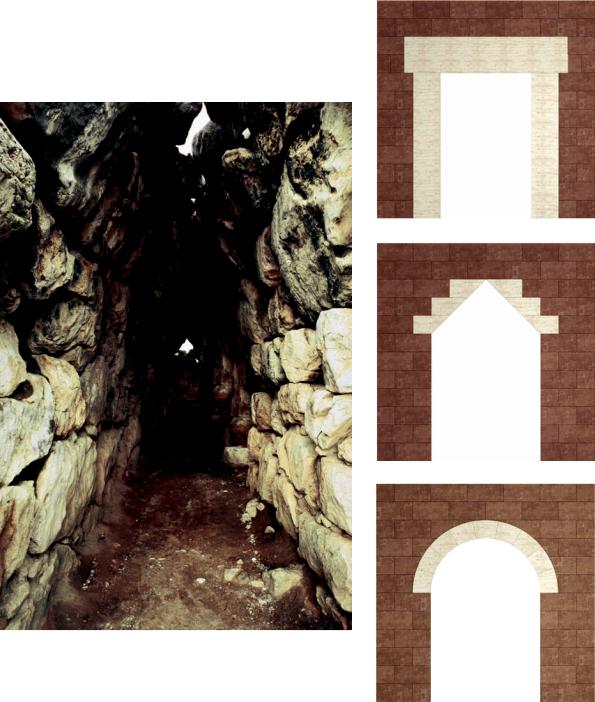
Architecture
The destruction of the Cretan palaces left the mainland culture supreme. Although this Late Helladic civilization has come to be called Mycenaean, Mycenae was but one of several large palace complexes. Archaeologists have also unearthed Mycenaean remains at Tiryns, Orchomenos, Pylos, and elsewhere, and Mycenaean fortification walls have even been found on the Acropolis of Athens. The best-preserved and most impressive Mycenaean remains are those of the fortified palaces at Tiryns and Mycenae. Both were built beginning about 1400 BCE and burned (along with all the others) between 1250 and 1200 BCE, when the Mycenaeans seem to have been overrun by northern invaders or to have fallen victim to internal warfare.
TIRYNS Homer knew the citadel of Tiryns (FIG. 4-15), located about 10 miles from Mycenae, as Tiryns of the Great Walls. In the second century CE, when Pausanias, author of an invaluable guidebook to Greece, visited the long-abandoned site, he marveled at the towering fortifications and considered the walls of Tiryns as spectacular as the pyramids of Egypt. Indeed, the Greeks of the historical age believed mere humans could not have erected such edifices and instead attributed the construction of the great Mycenaean citadels to the
mythical Cyclopes, a race of one-eyed giants. Historians still refer to the huge, roughly cut stone blocks forming the massive fortification walls of Tiryns and other Mycenaean sites as Cyclopean masonry.
The heavy walls of Tiryns and Mycenae contrast sharply with the open Cretan palaces (FIG. 4-4) and clearly reveal their defensive character. Those of Tiryns average about 20 feet in thickness, and in one section they house a long gallery (FIG. 4-16) covered by a corbeled vault (FIG. 4-17b) similar to that constructed long before at Neolithic Newgrange (FIG. 1-19). At Tiryns, the builders piled the large, irregular Cyclopean blocks in horizontal courses and then cantilevered them inward until the two walls met in a pointed arch. No mortar was used, and the vault is held in place only by the weight of the blocks (often several tons each), by the smaller stones used as wedges, and by the clay that fills some of the empty spaces. This primitive but effective vaulting scheme possesses an earthy monumentality. It is easy to see how a later
4-16 Corbeled gallery in the walls of the citadel, Tiryns, Greece, ca. 1400–1200 BCE.
The walls of Tiryns contain a long corbel-vaulted gallery in which irregular Cyclopean blocks were piled in horizontal courses and then cantilevered inward until the two walls met in a pointed arch.
a
b
c
4-17
Three methods of spanning a passageway:
(a) post and lintel, (b) corbeled arch, (c) arch.
Post-and-lintel construction (a) was the norm in ancient Greece,
but the Mycenaeans also used corbeled arches (b). The round arch (c), used already in the Near East, was popular in Rome.
Mycenaean Art |
77 |
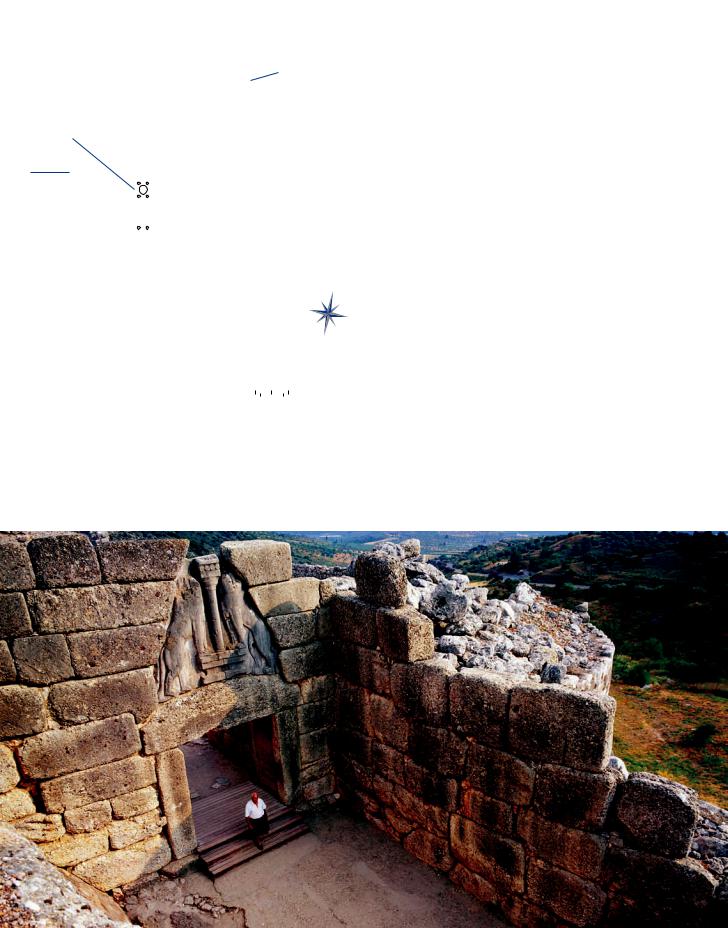
Approach ramp
Megaron
 Main gate
Main gate
Citadel walls
 Citadel
Citadel
walls
N
Outer propylon
0 |
25 50 |
75 |
100 feet |
||||||
|
|
|
|
|
|
|
|
|
|
|
|
|
|
|
|
|
|||
0 |
10 |
|
20 |
|
30 meters |
||||
4-18 Plan of the palace and southern part of the citadel, Tiryns, Greece, ca. 1400–1200 BCE.
The king’s reception and throne room, or megaron, was the main feature of Mycenaean palaces. Its plan, consisting of a hall with a columnar porch, is similar to that of early Greek temples (FIG. 5-6).
age came to believe that the uncouth Cyclopes were responsible for these massive but unsophisticated fortifications.
Would-be attackers at Tiryns were compelled to approach the palace (FIG. 4-18) within the walls via a long ramp that forced the (usually right-handed, as in FIG. 4-25) soldiers to expose their unshielded sides to the Mycenaean defenders above. Then—if they got that far—they had to pass through a series of narrow gates that also could be defended easily. Inside, at Tiryns as elsewhere, the most important element in the palace plan was the megaron, or reception hall and throne room, of the king. The main room of the megaron had a throne against the right wall and a central hearth bordered by four Minoan-style wooden columns serving as supports for the roof. A vestibule with a columnar facade preceded the throne room. A variation of this plan later formed the core of some of the earliest Greek temple plans (FIG. 5-6), suggesting some architectural continuity between the Mycenaean age and historical Greece.
LION GATE, MYCENAE The severity of these fortresspalaces was relieved by frescoes, as in the Cretan palaces, and, at Agamemnon’s Mycenae at least, by monumental architectural sculpture. The so-called Lion Gate (FIG. 4-19) is the outer gateway of the stronghold at Mycenae. It is protected on the left by a wall built on a natural rock outcropping and on the right by a projecting bastion of large blocks. Any approaching enemies would have had to enter this 20-foot-wide channel and face Mycenaean defenders above them on both sides. The gate itself consists of two great monoliths capped with a huge lintel (FIG. 4-17a). Above the lintel, the masonry courses form a corbeled arch (FIG. 4-17b), leaving an opening that lightens the weight the lintel carries. Filling this relieving triangle (FIG. 4-1) is a great limestone slab where two lions carved in high relief stand on the sides of a Minoan-type column. The whole design admirably matches its triangular space, harmonizing in dignity, strength, and scale with the mas-
4-19 Lion Gate, Mycenae, Greece, ca. 1300–1250 BCE. Limestone, relief panel 9 6 high.
The largest sculpture in the prehistoric Aegean is the relief of confronting lions (FIG. 4-1) that fills the relieving triangle of Mycenae’s main gate. The gate itself consists of two great monoliths and a huge lintel.
78 Chapter 4 T H E P R E H I S TO R I C A E G E A N
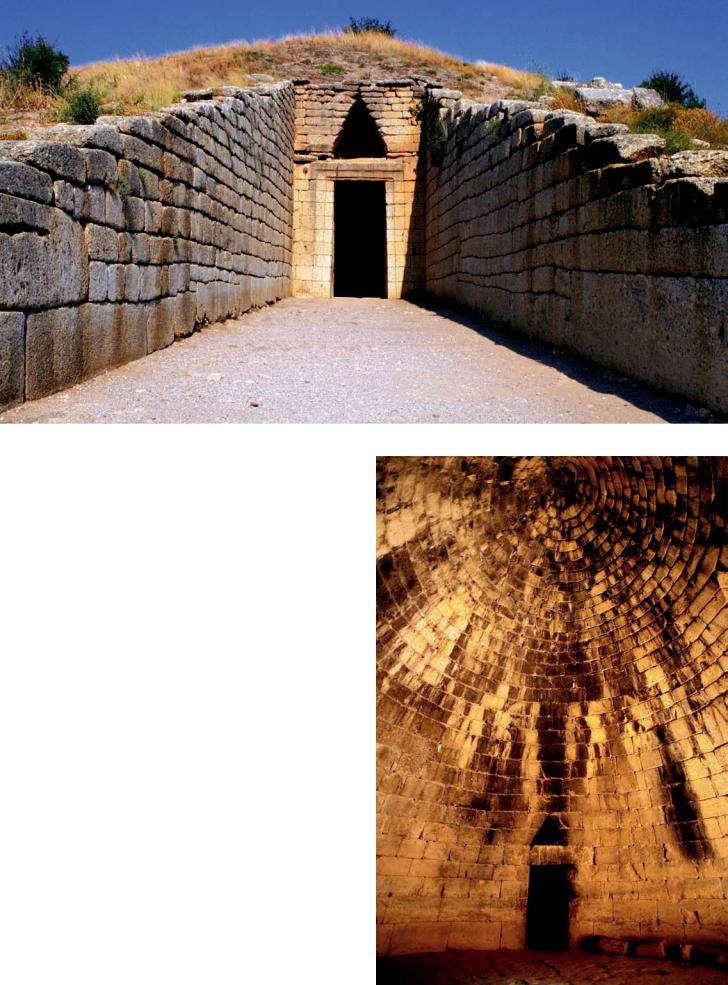
4-20 Treasury of Atreus, Mycenae, Greece, ca. 1300–1250 BCE.
The best-preserved Mycenaean tholos tomb is named for Homer’s King Atreus. An earthen mound covers the burial chamber, which is accessed through a doorway at the end of a long passageway.
sive stones that form the walls and gate. Similar groups appear in miniature on Cretan seals, but the idea of placing monstrous guardian figures at the entrances to palaces, tombs, and sacred places has its origin in the Near East and Egypt (FIGS. 2-18, 2-21, and 3-11). At Mycenae the animals’ heads were fashioned separately and are lost. Some scholars have suggested that the “lions” were actually composite beasts in the Eastern tradition, possibly sphinxes.
TREASURY OF ATREUS The Lion Gate at Mycenae and the towering fortification wall circuit of which it formed a part were constructed a few generations before the presumed date of the Trojan War. At that time, wealthy Mycenaeans were laid to rest outside the citadel walls in beehive-shaped tombs covered by enormous earthen mounds. Nine are preserved at Mycenae and scores more at other sites. The best-preserved of these tholos tombs is Mycenae’s socalled Treasury of Atreus (FIG. 4-20), which already in antiquity was mistakenly believed to be the repository of the treasure of Atreus, father of Agamemnon and Menelaus. Approached by a long passageway (dromos), the tomb chamber was entered through a doorway surmounted by a relieving triangle similar to that employed in the roughly contemporary Lion Gate. (As in the Lion Gate, the open triangle was originally covered. Both the doorway and the relieving triangle also once had engaged columns on each side, preserved in fragments today.) The tholos (FIG. 4-21) is composed of a series of
4-21 Vault of the tholos of the Treasury of Atreus, Mycenae, Greece, ca. 1300–1250 BCE.
The beehive-shaped tholos of the Treasury of Atreus is composed of corbeled courses of stone blocks laid on a circular base. The 43-foot- high dome was the largest in the world for almost 1,500 years.
Mycenaean Art |
79 |
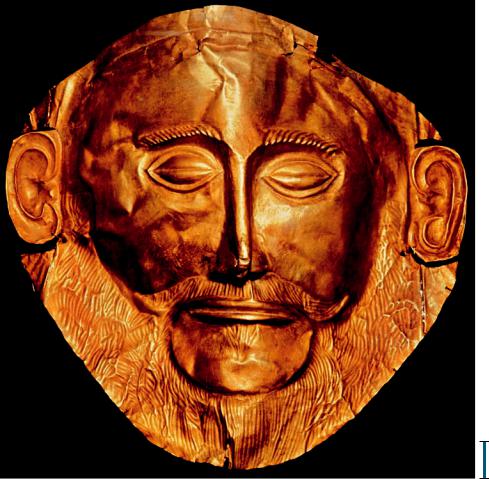
stone corbeled courses laid on a circular base to form a lofty dome. The builders probably constructed the vault using rough-hewn blocks. After they set the stones in place, the masons had to finish the surfaces with great precision to make them conform to both the horizontal and vertical curves of the wall. The principle involved is no different from that of the corbeled gallery (FIG. 4-16) of Tiryns. But the problem of constructing a complete dome is much more complicated, and the execution of the vault in the Treasury of Atreus is far more sophisticated than that of the vaulted gallery at Tiryns. About 43 feet high, this was at the time the largest vaulted space without interior supports that had ever been built. The achievement was not surpassed until the Romans constructed the Pantheon (FIG. 7-51) almost 1,500 years later using a new technology—concrete construc- tion—unknown to the Mycenaeans.
Metalwork, Sculpture, and Painting
The Treasury of Atreus had been thoroughly looted long before its modern rediscovery, but excavators have found spectacular grave goods elsewhere at Mycenae. Just inside the Lion Gate, Schliemann uncovered what archaeologists now designate as Grave Circle A. It predates the Lion Gate and the walls of Mycenae by some three centuries. Grave Circle A encloses six deep shafts that had served as tombs for kings and their families. The Mycenaeans laid their dead to rest on the floors of these shaft graves with masks covering their faces, recalling the Egyptian funerary practice. They buried women with their jewelry and men with their weapons and golden cups.
MASKS AND DAGGERS Among the most spectacular of Schliemann’s finds is a gold mask (FIG. 4-22), one of several from
4-22 Funerary mask, from Grave Circle A, Mycenae, Greece,
ca. 1600–1500 BCE. Beaten gold, 1 high.
National Archaeological Museum, Athens.
Homer described the Mycenaeans as “rich in gold.” This beaten gold (repoussé) mask of a bearded man comes from a royal shaft grave. It is one of the first attempts at life-size sculpture in Greece.
the royal burial complex. The Mycenaean masks were made using the repoussé technique, that is, the goldsmiths hammered the shape from a single sheet of metal and pushed the features out from behind. The mask illustrated here has often been compared to Tutankhamen’s gold mummy mask (FIG. 3-1). The treatment of the human face is, of course, more primitive in the Mycenaean mask. But this was one of the first attempts in Greece to render the human face at life-size, whereas Tutankhamen’s mask stands in a long line of monumental Egyptian sculptures going back more than a millennium. It is not known whether the Mycenaean masks were intended as portraits, but the goldsmiths recorded different physical types with care. They portrayed youthful faces as well as mature ones. The illustrated example (FIG. 4-22), with its full beard, must depict a mature man, perhaps a king—although not Agamemnon, as Schliemann wished. If Agamemnon was a real king, he lived some 300 years after this mask was fashioned. Clearly the Mycenaeans were “rich in gold” long before Homer’s heroes fought at Troy.
Also found in Grave Circle A were several magnificent bronze dagger blades inlaid with gold, silver, and niello (a black metallic alloy), again attesting to the wealth of the Mycenaean kings as well as to their warlike nature. The largest and most elaborate of the group is decorated on one side (FIG. 4-23) with a scene of four hunters attacking a lion that has struck down a fifth hunter, while two other lions flee. The other side shows lions attacking deer. The slimwaisted, long-haired figures are Minoan in style, but the artist borrowed the subject from the repertoire of the ancient Near East. It is likely that a Minoan metalworker made the dagger for a Mycenaean patron who admired Minoan art but whose taste in subject matter differed from that of his Cretan counterparts.
1 in.
80 Chapter 4 T H E P R E H I S TO R I C A E G E A N
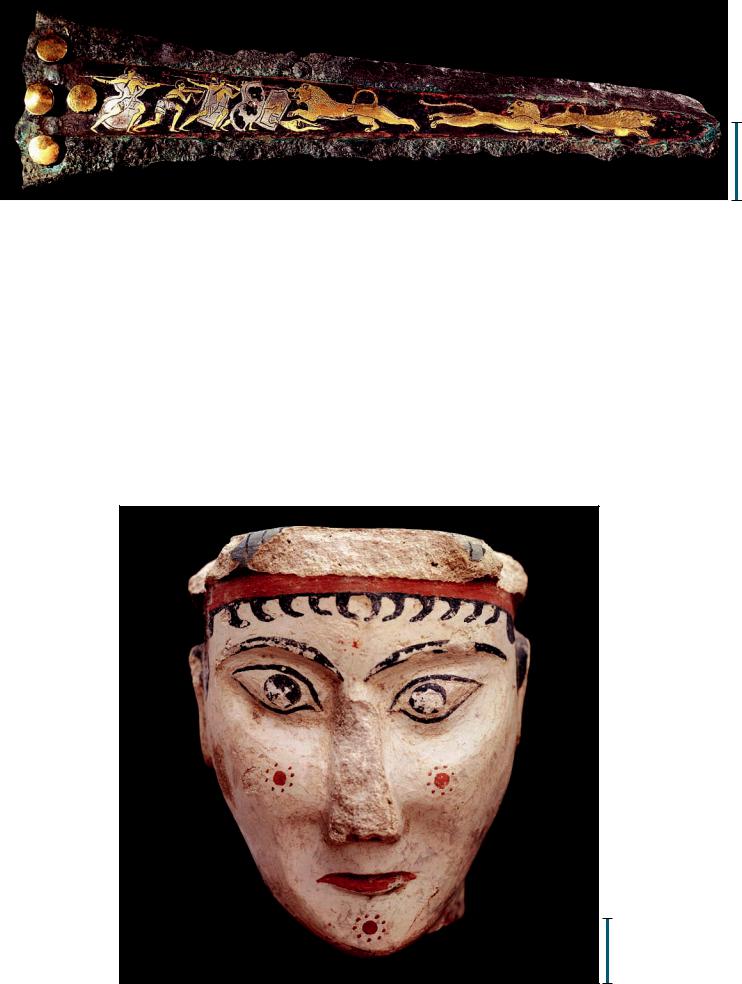
1 in.
4-23 Inlaid dagger blade with lion hunt, from Grave Circle A, Mycenae, Greece, ca. 1600–1500 BCE. Bronze, inlaid with gold, silver, and niello, 9 long. National Archaeological Museum, Athens.
The treasures buried with the Mycenaean kings attest to their wealth. The lion hunters on this bronze dagger are Minoan in style, but the metalworker borrowed the subject from the artistic repertory of the Near East.
PLASTER SCULPTURE Large-scale figural art is very rare on the Greek mainland, as on Crete, other than the Minoan-style paintings that once adorned the walls of Mycenaean palaces. The triangular relief (FIG. 4-1) of the Lion Gate at Mycenae is exceptional, as is the painted plaster head (FIG. 4-24) of a woman, goddess, or, perhaps, sphinx found at Mycenae. The white flesh tone indicates that the head is female. The hair and eyes are dark blue, almost black, and the lips, ears, and headband are red. The artist decorated the cheeks and chin with red circles surrounded by a ring of red dots, recalling
the facial paint or tattoos recorded on Early Cycladic figurines of women. Although the large staring eyes give the face a menacing, if not terrifying, expression appropriate for a guardian figure such as a sphinx, the closest parallels to this work in the prehistoric Aegean are terracotta images of goddesses. This head may therefore be a very early example of a monumental cult statue in Greece.
Were it not for this plaster head and a few other exceptional pieces, art historians might have concluded—wrongly—that the Mycenaeans had no monumental freestanding statuary—a reminder that it is
4-24 Female head, from Mycenae, Greece, ca. 1300– 1250 BCE. Painted
plaster, 6 – high.
1
2
National Archaeological Museum, Athens.
This painted white plaster head of a woman with large staring eyes may be a very early example of a monumental statue of a goddess in Greece, but some scholars think it is the head of a sphinx.
1 in.
Mycenaean Art |
81 |
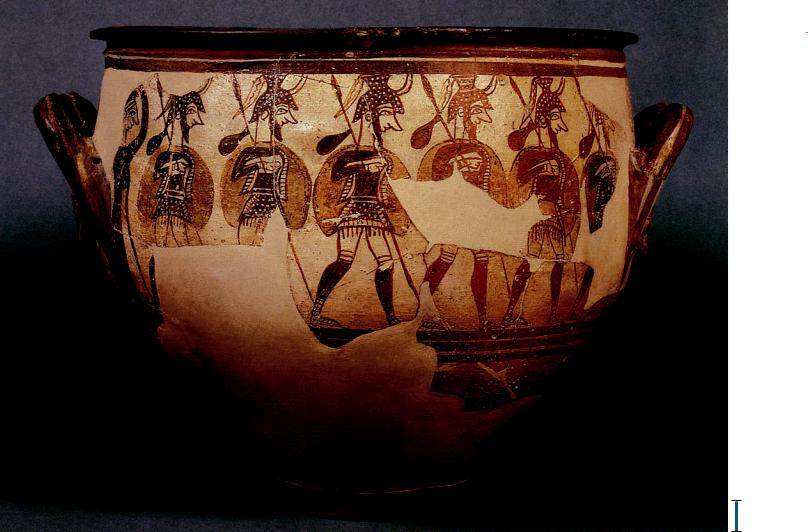
1 in.
4-25 Warriors Vase, from Mycenae, Greece, ca. 1200 BCE. 1 4 high. National Archaeological Museum, Athens.
This krater, or mixing bowl, shows a woman bidding farewell to a column of heavily armed Mycenaean warriors depicted using both silhouette and outline and a combination of frontal and profile views.
always dangerous to generalize from the fragmentary remains of an ancient civilization. Nonetheless, life-size Aegean statuary must have been rare. After the collapse of Mycenaean civilization and for the next several hundred years, no attempts at monumental statuary are evident until, after the waning of the so-called Dark Ages, Greek sculptors were exposed to the great sculptural tradition of Egypt (see Chapter 5).
WARRIORS VASE An art form that did continue throughout the period after the downfall of the Mycenaean palaces was vase painting. One of the latest examples of Mycenaean painting is the krater (bowl for mixing wine and water) commonly called the Warriors Vase (FIG. 4-25) after its prominent frieze of soldiers marching off to war. At the left a woman bids farewell to the column of heavily
armed warriors moving away from her. The painting on this vase reveals no setting and lacks the landscape elements that characterized earlier Minoan and Mycenaean art. All the soldiers also repeat the same pattern, a far cry from the variety and anecdotal detail of the lively procession of the Minoan Harvesters Vase (FIG. 4-14).
This simplification of narrative has parallels in the increasingly schematic and abstract treatment of marine life on other painted vases. The octopus, for example, eventually became a stylized motif composed of concentric circles and spirals that are almost unrecognizable as a sea creature. By Homer’s time, the heyday of Aegean civilization was but a distant memory, and the men and women of Crete and Mycenae—Minos and Ariadne, Agamemnon and Helen—had assumed the stature of heroes from a lost golden age.
82 Chapter 4 T H E P R E H I S TO R I C A E G E A N
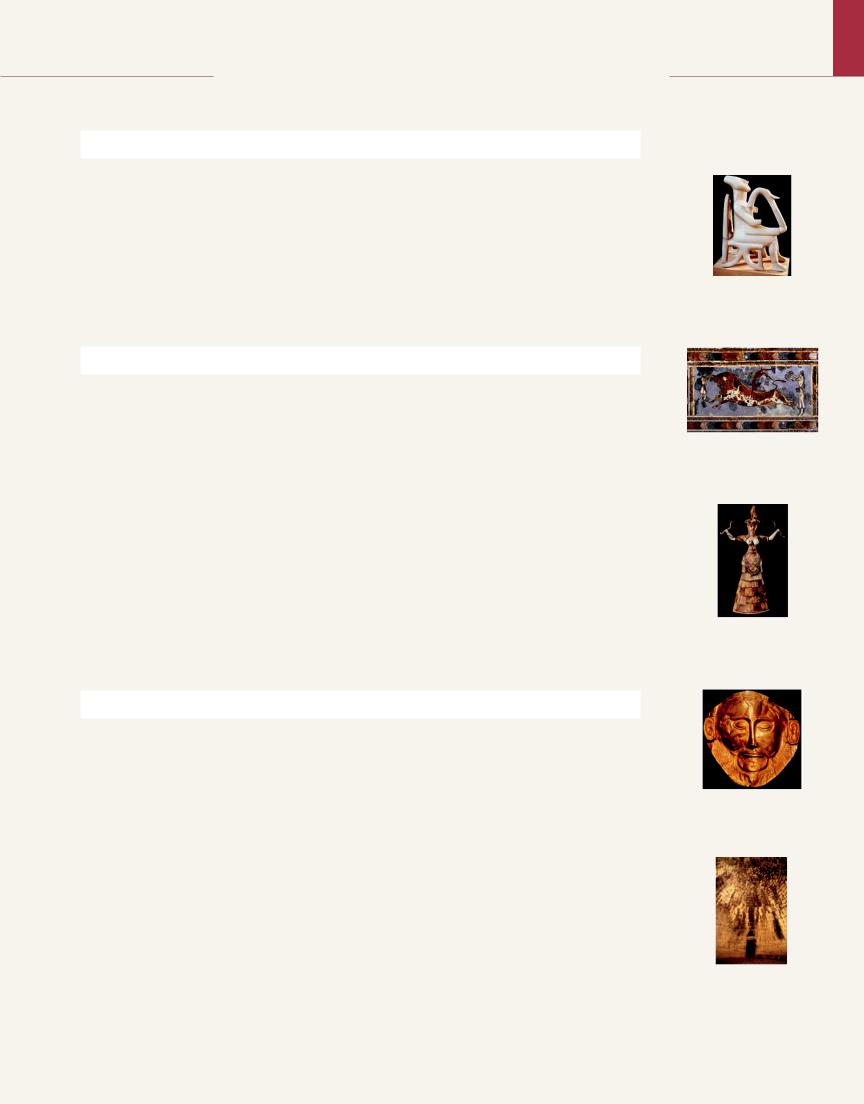
T H E B I G P I C T U R E
T H E P R E H I S T O R I C A E G E A N
EARLY CYCLADIC ART, ca. 3000–2000 BCE
Marble statuettes are the major surviving artworks of the Cycladic Islands during the third millennium BCE, but little is known about their function.
Many of the Cycladic figurines were buried in graves and may represent the deceased, but others, for example, musicians, almost certainly do not. Whatever their meaning, these statuettes mark the beginning of the long history of marble sculpture in Greece.
LATE MINOAN ART, ca. 1700–1200 BCE
The so-called Old Palace period (ca. 2000–1700 BCE) on Crete saw the construction of the first palaces on the island, but the golden age of Crete was the Late Minoan period.
The greatest Late Minoan palace was at Knossos. A vast multistory structure arranged around a central court, the Knossos palace was so complex in plan that it gave rise to the myth of the Minotaur in the labyrinth of King Minos.
The largest art form in the Minoan world was fresco painting on walls, usually illustrating palace rituals like bull-leaping.
Vase painting also flourished. Sea motifs, for example, the octopus, were popular subjects.
Minoan sculpture was of small scale, consisting of statuettes of “snake goddesses” and reliefs on stone vases.
MYCENAEAN (LATE HELLADIC) ART, ca. 1700–1200 BCE
The Mycenaeans, who with their Greek allies later waged war on Troy, were already by 1600–1500 BCE burying their kings in deep shaft graves with gold funerary masks and bronze daggers inlaid with gold and silver.
By 1450 BCE, the Mycenaeans had occupied Crete, and between 1400 and 1200 BCE, they erected great citadels at Mycenae, Tiryns, and elsewhere with “Cyclopean” walls of huge, irregularly shaped stone blocks.
Masters of corbel vaulting, the Mycenaeans also erected beehive-shaped tholos tombs like the so-called Treasury of Atreus, which had the largest dome in the pre-Roman world.
The oldest preserved monumental sculptures in Greece, most notably Mycenae’s Lion Gate, date to the end of the Mycenaean period.
Lyre player, Keros, ca. 2700–2500 BCE
Bull-leaping fresco, Knossos, ca. 1450–1400 BCE
Snake Goddess, Knossos,
ca. 1600 BCE
Gold funerary mask, Mycenae, ca. 1600–1500 BCE
Vault of the Treasury of Atreus,
Mycenae, ca. 1300–1250 BCE
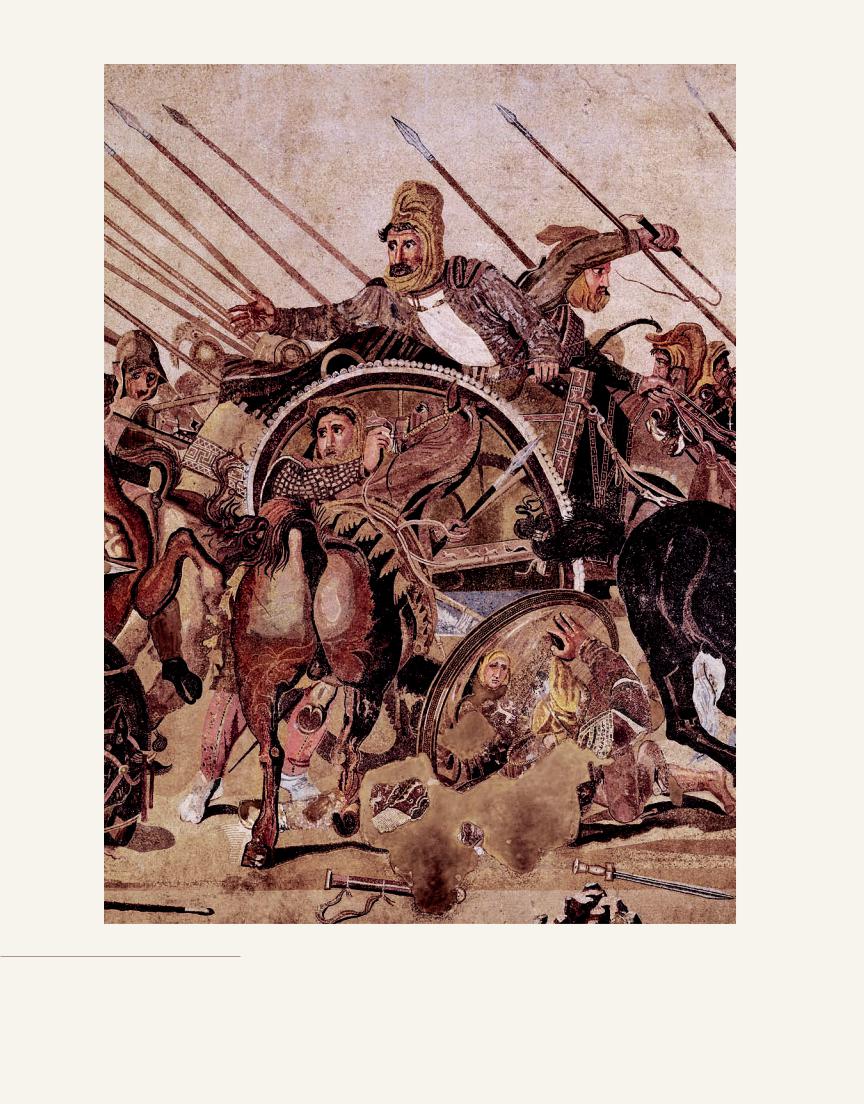
5-1 The Persian king Darius III, detail of PHILOXENOS OF ERETRIA, Battle of Issus (FIG. 5-70), Roman mosaic copy of a painting of ca. 310 BCE. Museo Archeologico Nazionale, Naples.
Greek painters were the first to employ foreshortening consistently, to model figures in color, and to depict reflections and shadows—practices that became standard in later painting in the Western world.
